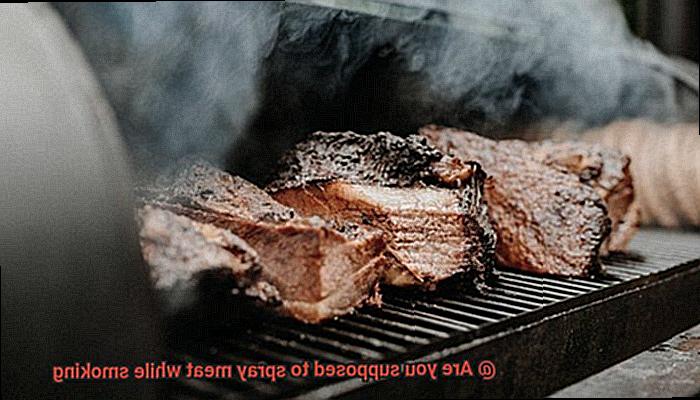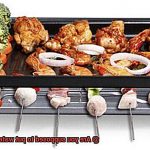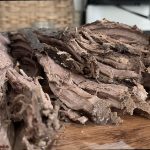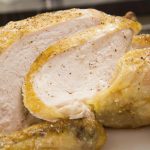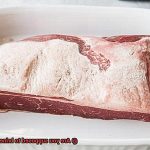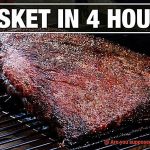Smoking meat is a culinary art that requires patience, time, and a keen understanding of the smoking process. For any barbecue enthusiast, smoking meat can be an incredibly satisfying experience that tantalizes the taste buds. However, to achieve that perfect smoky flavor, it’s essential to maintain the meat’s moisture level throughout the cooking process.
That brings us to the question – should you spray your meat while smoking? There are two schools of thought on this topic. Some pitmasters believe that spraying meat during the cooking process infuses flavor, keeps it moist and prevents it from drying out. On the other hand, others argue that opening up the lid to spray causes a drop in temperature and smoke loss, which negatively affects the overall flavor profile.
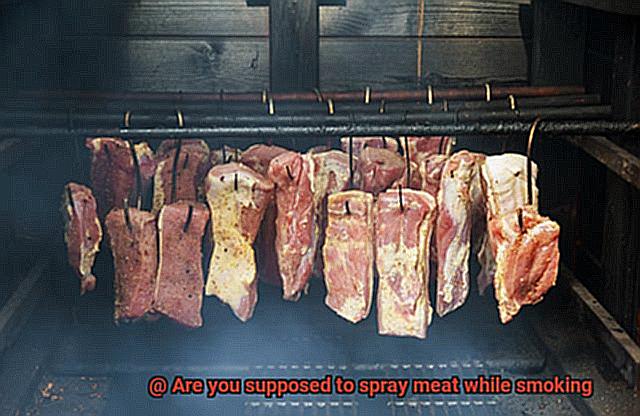
In this blog post, we’ll dive deep into the world of smoking meat and explore whether or not spritzing is necessary for success. We’ll cover everything from why there’s disagreement on this topic to which meats benefit most from spritzing. You’ll learn about different types of liquids used for spritzing and how often you should do it. Moreover, we’ll share some alternative ways to keep your meat juicy without spritzing.
So, buckle up and get ready to take your smoking game to new heights.
Contents
Pros of Spraying Meat While Smoking
As someone who has spent years perfecting the art of smoking meat, I can attest to the fact that there’s a lot of discussion surrounding whether or not to spray your meat while it’s smoking. While some people argue that spraying can interfere with the formation of a flavorful bark on the outside of the meat, others swear by its ability to keep the meat moist and tender. In this piece, we’ll be discussing the pros of spraying meat while smoking.
One of the most significant benefits of spraying meat while smoking is that it can help prevent the meat from drying out. Smoking meat is a slow process that can take several hours, and during this time, the moisture in the meat can evaporate, leading to dry and tough meat. Spritzing your meat periodically with liquid, such as apple juice, beer, or a simple water and vinegar mixture, can help keep its surface moist and prevent it from drying out.
Another advantage of spraying your meat while smoking is that it can enhance its flavor. By spritzing your liquid onto the surface of the meat, you’ll be carrying flavorings and spices into it, resulting in a more flavorful end product. For instance, if you’re smoking pork shoulder, you might consider spraying it with apple juice mixed with cinnamon and brown sugar to infuse those flavors into the meat.
In addition to keeping your meat moist and enhancing its flavor, spraying it while smoking can also create an attractive appearance for the finished product. When done correctly, spraying can help create a caramelized crust on the outside of the meat that is both visually appealing and delicious.
It’s worth noting that some people believe that too much moisture can hinder smoke absorption and lead to a less flavorful end product. However, as long as you spray sparingly and avoid overdoing it, this shouldn’t be an issue.
Cons of Spraying Meat While Smoking
You’re standing in front of your smoker, ready to smoke some meat to perfection. You may be tempted to grab that spray bottle and give your meat a little spritz every now and then, but before you do, let’s explore the cons of spraying meat while smoking.
Firstly, spraying your meat while smoking can make it excessively moist, leading to a mushy texture that nobody desires. This is especially true when using a water-based spray as it can saturate the meat and cause it to lose its natural flavor and texture. To avoid this, try using a dry rub or marinade to infuse flavor without making your meat soggy.
Furthermore, spraying meat while smoking can interfere with the formation of a delectable crust on the surface of your meat. Smoke and heat combine to create a chemical reaction known as the Maillard reaction that forms a delicious crust on the meat. Spraying liquid on your meat can hinder this process, leaving you with less flavorful meat.
In addition, every time you open the smoker to spray your meat, you’re releasing heat and smoke. This can lead to temperature fluctuations that negatively impact the quality of your meat. The more you open and close the smoker, the longer it will take for your meat to cook, which can cause it to dry out or become tough.
To ensure the best possible outcome for your smoked meats, it’s best to avoid spraying them altogether. Instead, focus on using a dry rub or marinade to enhance their flavor and texture. Trust us – your taste buds (and your guests) will thank you.
How to Properly Spray Meat While Smoking
Smoking meat is a labor of love, and for many pitmasters, spraying the meat is an essential part of the process. Done properly, spraying helps keep the meat moist and flavorful. But it’s important to do it right, or you risk ruining the final product. In this blog post, we will explore how to properly spray meat while smoking with five key subtopics.
What does spraying mean in smoking?
Spraying refers to the act of adding moisture to the meat during the smoking process using a spray bottle filled with liquid. This liquid could be anything from water to apple juice or vinegar. The purpose of spraying is to keep the meat moist and prevent it from drying out during the smoking process. Additionally, it can enhance the flavor of the meat by infusing it with a subtle sweetness or other flavors.
Why is spraying important?
Spraying is important because it serves multiple purposes. Firstly, it helps regulate the temperature of the meat by creating a barrier between it and the heat source. Secondly, it adds moisture to the surface of the meat, which keeps it from drying out and becoming tough. Finally, it can enhance the flavor of the meat by adding complementary notes that complement its natural taste.
How to choose the right liquid for your meat?
Choosing the right liquid is crucial to achieving the desired flavor and texture of your smoked meat. Different liquids work better with different cuts of meat. For example, fruit juices work well with pork and poultry, while beer or wine can enhance beef flavors. Many pitmasters prefer using apple cider vinegar or apple juice mixed with water as a base. This adds a subtle sweetness to the meat and helps keep it moist without overpowering its natural flavor.
How often should you spray your meat?
Spray your meat every hour or so during the smoking process, being careful not to disturb any rub or seasoning on the surface. It’s also important to avoid spraying too frequently, as this can cause the temperature of the smoker to drop and extend the cooking time. The goal is to keep the meat moist without interfering with the cooking process.
How to apply spray correctly?
When applying spray, use a spray bottle with a fine mist setting to evenly distribute the liquid over the surface of the meat. Be sure not to oversaturate one area, as this can cause uneven cooking and affect the final texture of the meat. It’s also important to avoid opening the smoker too frequently when spraying, as this can cause fluctuations in temperature and prolong the cooking time. Instead, quickly open the smoker, apply the spray, and then close it again.
Different Types of Liquids to Use for Spraying
Smoking meat is a cooking method that many people enjoy because it enhances the natural flavors of the meat. However, some people like to go the extra mile by spritzing their meat with liquid during the cooking process to add even more flavor and moisture. If you’re thinking about trying this technique, here are some different types of liquids that can be used for spraying meat while smoking.
Apple Juice
Apple juice is a popular choice among smokers because it adds a sweet flavor to the meat while also helping to keep it moist. It’s important to use 100% apple juice without any added sugars or preservatives to avoid burning or caramelizing on the surface of the meat.
Apple Cider Vinegar
If you’re looking for a tangy flavor and want to tenderize your meat, apple cider vinegar is an excellent option. It’s acidic nature can help break down the muscle fibers in the meat, making it more tender. It also adds a tangy taste that complements the smoky flavor of the meat.
Beer, Wine or Whiskey
For those who want to add a unique flavor to their meat, beer, wine, and whiskey are popular options. Beer can add a bitter taste to the meat, while wine and whiskey can provide smoky and sweet notes. However, it’s important not to overuse alcohol as it can overpower the natural taste of the meat.
Water
Water is an excellent choice for those who want to keep things simple. It helps keep the meat moist without adding any additional flavors or sweetness. It’s also readily available and doesn’t require any special preparation.
Broth
Broth, whether chicken or beef, can add a savory flavor to your smoked meat. It can also provide additional moisture to prevent your meat from drying out during cooking.
What Is the Best Temperature for Smoking Meat?
Smoking meat is a culinary art that requires patience, skill, and precision. While the process may seem simple at first glance, it’s crucial to understand that temperature plays a critical role in determining the final outcome of your smoked meats.
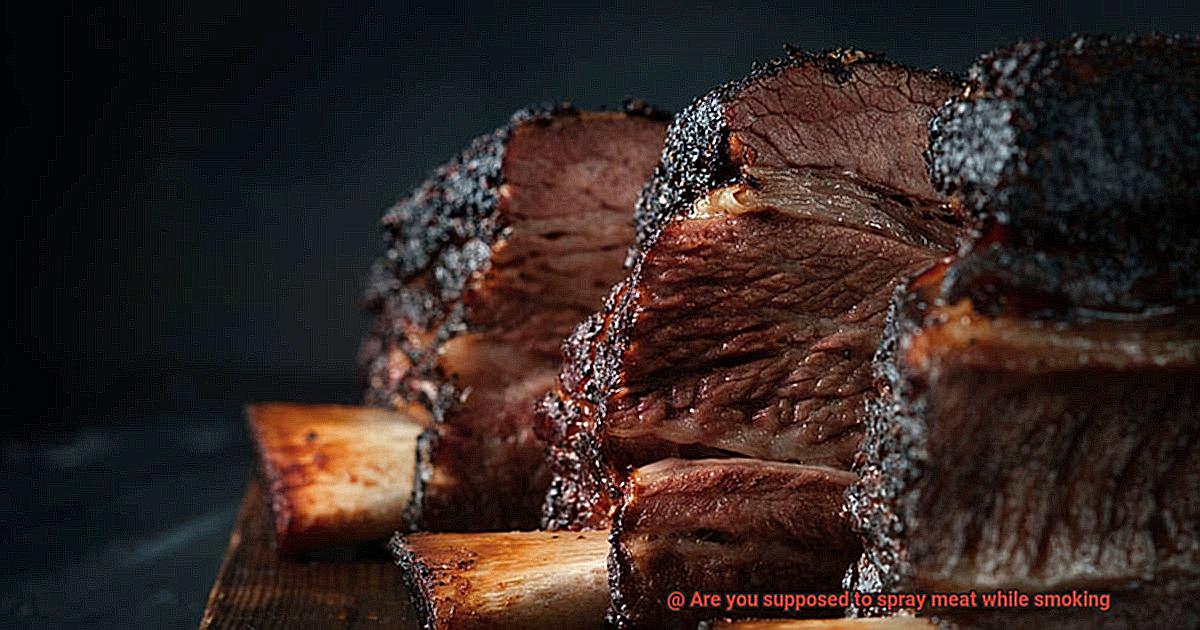
So, what is the ideal temperature for smoking meat? The answer is not straightforward as it varies depending on the type of meat you’re cooking and your desired outcome. However, we can offer some general guidelines to help you get started on your smoking journey.
Firstly, let’s discuss beef brisket, one of the most popular meats to smoke. To achieve a tender and juicy brisket, aim for a temperature range between 225-250°F. This low and slow cooking method gradually breaks down the tough connective tissue in the brisket, resulting in a melt-in-your-mouth texture.
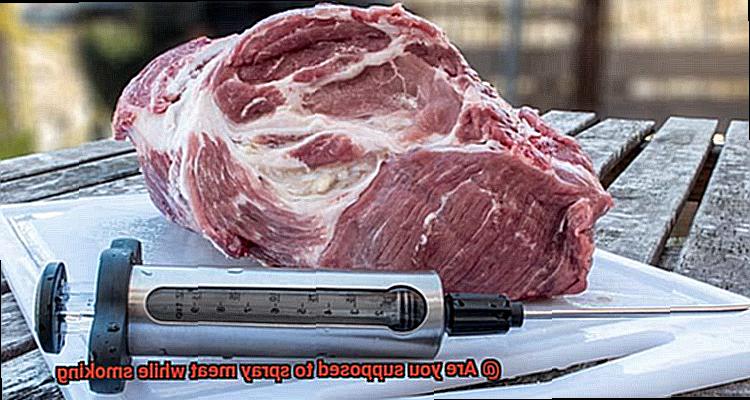
Next up is pork shoulder, which is similar to brisket in terms of its tough connective tissue. For pork shoulder, you’ll want to smoke it at a similar temperature range of 225-250°F for optimal results.
When it comes to ribs, you can smoke them at a slightly higher temperature range of 250-275°F. Ribs have less connective tissue than brisket and pork shoulder, so they can handle a slightly higher temperature without drying out.
Moving on to poultry, chicken and turkey require a higher temperature range between 275-300°F. This ensures that the meat cooks through thoroughly while retaining its moisture and flavor.
Finally, we have fish, which requires a lower temperature range of around 175-200°F. Cooking fish at too high a temperature can cause it to dry out quickly, so it’s essential to keep the heat low and steady.
It’s worth noting that maintaining consistent temperatures throughout the smoking process is crucial for achieving great results. Fluctuations in temperature can lead to uneven cooking and unsatisfactory end results. Therefore, investing in a reliable smoker or grill with precise temperature control is a wise choice.
Tips and Tricks for a Perfect Smoked Meal
Spraying meat while smoking can be a great technique to achieve the perfect smoked meal. However, it is important to understand the benefits and drawbacks of this method.
Moisture Retention
One of the biggest benefits of spraying meat while smoking is moisture retention. The smoking process can often dry out meats, especially when cooking at higher temperatures or for longer periods of time. Spraying the meat with a liquid such as apple juice, cider vinegar, or water can help keep it moist and prevent it from becoming tough.
Flavor Enhancement
Spraying your meat can also add an extra layer of flavor to your smoked meats. Many pitmasters create their own spritzing solution using a combination of fruit juices, vinegar, and spices to enhance the flavor. This technique is particularly effective when smoking larger cuts of meat like brisket or pork shoulder.
Not Necessary for All Meats
It is important to note that not all meats require spraying while smoking. For instance, pork ribs and brisket typically do not require spraying, as they have enough fat content to keep them moist throughout the smoking process.
Hinders Bark Formation
While spraying can add moisture and flavor to your meat, over-spraying can lead to excessive surface moisture that may hinder the formation of a flavorful bark on the outside. It is crucial to use a light hand when spraying and only spray as needed.
Personal Preference
Ultimately, whether or not to spray your meat while smoking is a matter of personal preference and experimentation. Some pitmasters swear by spritzing their meat every hour, while others prefer to let the meat smoke without interruption. It’s important to monitor your meat closely and make adjustments as needed to achieve your desired results.
Common Mistakes When Smoking Meat with Spray
Smoking meat with spray can be a fantastic way to infuse flavor and moisture into your favorite cuts. However, there are some common pitfalls that many people fall into when using this technique. As an expert in the field, I have seen these mistakes time and time again. Here are some tips to help you avoid them and get the most out of your smoked meat.
First and foremost, over-spraying your meat is a major mistake. While it may seem like a good idea to douse your meat with liquid, too much can actually do more harm than good. Over-spraying can strip away the natural juices and flavors of the meat, as well as cause it to become mushy or soggy. Instead, aim for a light, even coating of spray.
Another mistake that people make is using the wrong type of liquid for spraying. While water can be effective in keeping your meat moist, it doesn’t contribute any additional flavor. On the other hand, sugary liquids like apple juice or cola can lead to a burnt or sticky exterior on your meat. Experiment with different liquids to find the perfect balance of moisture and flavor.
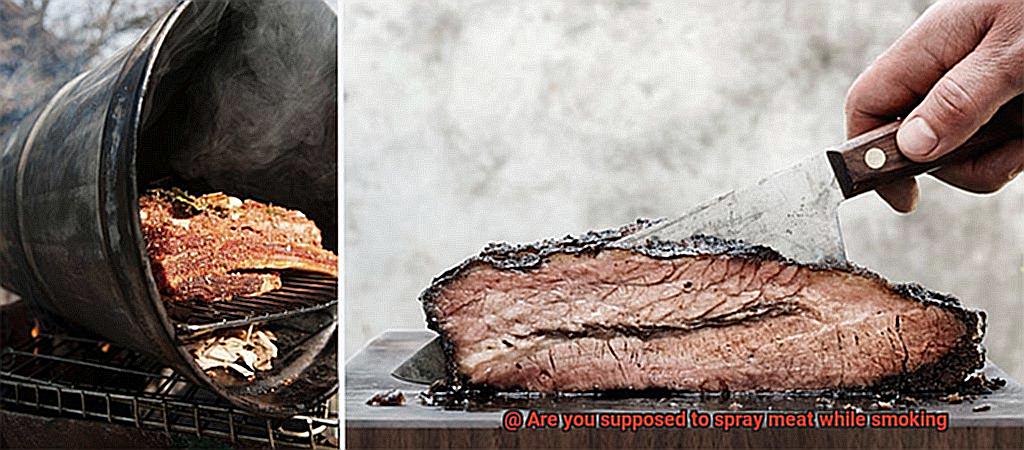
Timing is also crucial when it comes to spraying your meat. If you start too early in the cooking process, before a good bark has formed on the meat, the liquid will simply slide off instead of being absorbed and adding flavor. Wait until the bark has had a chance to develop before you start spraying.
Finally, don’t forget to adjust your smoking times when using spray. Adding liquid during the cooking process may extend cooking times, so be sure to keep an eye on the internal temperature of your meat and adjust accordingly.
Alternatives to Spraying Meat While Smoking
If you’re tired of constantly spraying your meat during the smoking process, fear not, because there are alternative methods that can achieve the same juicy and flavorful results without the added hassle or expense. As an expert in the field, I’m here to share with you some of the best alternative methods.
First up is basting. This method involves using a brush or mop to apply a flavorful liquid such as apple cider vinegar, beer or fruit juice to your meat. Basting allows you to control the amount of moisture added to your meat while also infusing it with your chosen flavors. It’s an easy and effective way to keep your meat moist and delicious.
Another option is wrapping your meat in foil or butcher paper during the smoking process. This creates a steamy environment that helps to keep your meat tender and juicy without any need for sprays or basting. Wrapping also helps to speed up the cooking process and adds a smoky flavor to your meat.
If you have a smoker equipped with a water pan, you can fill it with liquid to create steam and keep your meat moist throughout the smoking process. This simple and effective method requires no additional effort on your part.
sUu5fusrdGg” >
Conclusion
In the world of smoking meat, there are no shortcuts to achieving perfection. It takes a combination of patience, skill, and a deep understanding of the process to create mouthwatering meats that leave your guests begging for more. While opinions may vary on whether or not to spray meat while smoking, it’s clear that spritzing can be a game-changer when done right.
To achieve the perfect balance between moisture and flavor, it’s important to choose the right liquid for your meat and use it sparingly. Whether you opt for apple juice, cider vinegar, beer, wine, or water – each has its unique benefits and can enhance the overall taste of your meat. However, over-spraying can lead to excessive surface moisture that could hinder the formation of a flavorful bark on the outside.
Timing is also crucial when it comes to spraying your meat. Wait until a good bark has formed before you start spritzing. Alternatively, basting with a flavorful liquid or wrapping your meat in foil or butcher paper can achieve similar results without risking over-saturation.
If you’re looking for ways to keep your meat moist throughout the smoking process without using sprays or basting techniques, consider using a smoker equipped with a water pan. This method allows for consistent moisture levels without altering the flavor profile of your meat.
At the end of the day, whether or not to spray your meat while smoking is ultimately up to personal preference and experimentation.

